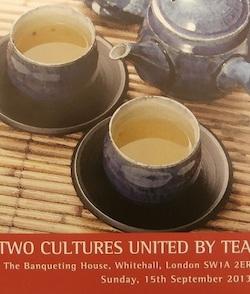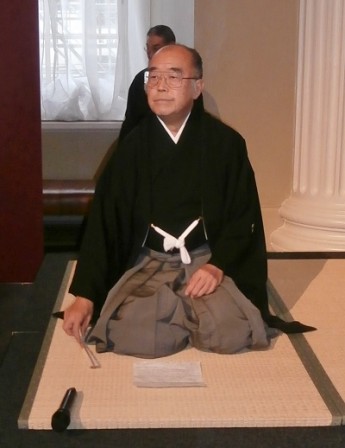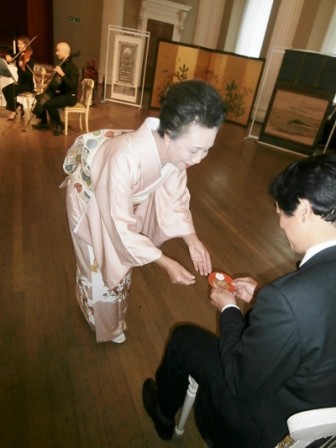Two Cultures United by Tea

The Banqueting House
Whitehall, London
SW1A 2ER
Sunday 15 September 2013
Review by Susan Meehan
Tea is the most widely-consumed beverage plant in the world and China one of the earliest countries to produce and use tea, possibly as early as 2750 BC.[1] The Zen Buddhist ritual of drinking tea before the image of the Bodhi Dharma, as mentioned by Okakura Tenshin in his much-loved (though unsubtle in its nationalistic bent and a product of its time, in the wake of the surprising Japanese victory over the Russians in the 1905 Russo-Japanese War) 1906 publication, ‘The Book of Tea,’ developed into the 15th-century Japanese tea ceremony as perfected and codified by the great tea master, Sen no Rikyu. According to Soshitsu Sen XV, a descendant of Sen no Rikyu writing in his forward to ‘The Book of Tea’ the great tea master strove to convey the tea ceremony as being a living synthesis of Asian and Japanese arts.
Yet tea is also quintessentially British. There can be no better way of bringing the Japanese and British together than through drinking tea. Soshitsu Sen XV, writing in his afterword to ‘The Book of Tea’, noted that tea “transcends the boundaries of nations.” He also stated, “It has been my conviction that world peace can be achieved starting with the exchange of tea between just two individuals.”
It had been at least two hours since my last pot of tea that Sunday, 15 September and I was looking forward to more at Banqueting House as I stepped out onto Whitehall in the rain. I was not as enthused by the prospect of those powdery, floury cloying Japanese tea sweets, which I imagined would certainly be offered to the guests, and which are eaten before drinking delicious, frothy, slightly bitter-tasting matcha (powdered green tea).
This tea event was a highlight of the Japan400 Week, marking the delivery of official letters and presents from King James I of England and VI of Scotland to Tokugawa Ieyasu and his son Hidetada on 8 and 17 September 1613 respectively, as part of their mission to set up the first English trading post in Japan. The bearer of the letters and gifts was John Saris, captain of the ‘Clove,’ accompanied by William Adams, the pilot of a Dutch ship which had been shipwrecked in Japan in 1603 and who had stayed on in Japan in the capacity of honorary samurai and advisor to Shogun Tokugawa Ieyasu ever since.
Two Cultures United by Tea succeeded in masterfully celebrating the 400th anniversary of the exchange of letters and presents initiated by Kings James I and commemorating the historical figures who were vital to success of the East India Company’s efforts to trade in Japan 400 years ago. The event brought the audience together over tea, that most unifying of all beverages, under this Royal Palace, Banqueting House’s magnificent Rubens ceiling which celebrates the life and ‘wise government’ of King James I. It is difficult to think of a more fitting or beautiful setting.
‘The Union of the Crowns’, ‘The Apotheosis of James I’ and ‘The Peaceful Reign of James I’ are the three canvases painted by Sir Peter Paul Rubens and installed to decorate the hall’s ceiling in 1636.
In addition to this most appropriate of settings, the presence of Mr Akira Matsura, Head of the Chinshin School of Tea Ceremony and a direct descendant of Lord Matsura, who ruled the area of Hirado in Japan on behalf of Hidetada Tokugawa at the time of the British ship the ‘Clove‘s’ arrival in Hirado on 11 June 1613 made the event all the more resonant.
Tea refreshes the spirit and, as Okakura Tenshin reveals in his ‘Book of Tea’ of it is what keeps the Zen monks awake during their long hours of meditation.
Taking my seat in the beautiful hall, I also noticed a half-built gold-coloured telescope on display. King James I had sent presents to the ruler of Japan, including a telescope, the first ever to reach Asia. Only having been invented in the Netherlands in1608, this was a precious gift indeed. Sadly the telescope was subsequently lost and Japan400 has set out to replace it with this new model, still a work in progress (web).
Welcoming all to the event, Nicolas Maclean, Co-Chairman of Japan400, read a short message of support for this commemoration of the 400th anniversary of the start of Japan-British relations from the Rt Hon William Hague MP, Secretary of State for Foreign and Commonwealth Affairs, in which he underlined “the value Her Majesty’s Government attached to that partnership today.”
This was followed by opening remarks given by HRH The Duke of Gloucester, Patron of the Japan Society, who remarked on tea being close to the heart of British people. If a crisis is brewing, the duke only half-joked, tea is called upon.
The Duke of Gloucester urged the audience to look at the breath-taking ceiling painted by Sir Peter Rubens, who had been Dutch Ambassador to London and the first artist to be knighted.
A leading expert on architecture, the duke recounted that Banqueting House had been designed by Inigo Jones, a court designer, who preferred neo-classicism over the baroque. Inigo Jones gave Banqueting House a sense of authority and elegance (its website refers to it being like a piece of “Ancient Rome transposed to Whitehall”) though its tremendous cost led to distrust between the king and Parliament and the latter’s discrediting of the king’s architecture.
Following the duke’s welcome, Mr Akira Mastura, the 41st-generation head of the Matsura family described how his ancestor, the 26th-generation head of the family, had greeted John Saris and crew at Hirado, the Matsura’s ancestral land.
On this visit to England, Mr Matsura had already, a few days previously, offered tea to the spirit of Will Adams at St Mary’s Church in Gillingham where Adams had been baptised.
Mr Matsura proceeded to conduct a ‘Kencha’ tea ceremony, preparing matcha in two cups dedicated to the souls of King James I and the Lord of Hirado (at the time of the ‘Clove’s’ arrival). Mr Matsura related that the Chinshin School had been developed by the Lord of Hirado and that he regards the tea ceremony as a way of cultivating the warrior or samurai’s cultural sensibility as well as training his mind for military purposes. The Kencha tea ceremony evolved precisely in order to dedicate bowls of tea to deities or the spirits of the deceased, particularly on important anniversaries.
With clinical precision Mr Matsura, clothed in a kimono and wearing a face-mask, knelt in front of a black lacquer cabinet which held a container of hot water and a pot of matcha. Carefully unwrapping a series of utensils for adding the powder to a bowl and to whisk the tea, Mr Matsura made a single bowl of tea in complete silence. When ready, the bowl was carried by a Japanese teenager (Nanko Suzuki) to a table in front of the throne of King James I. A second bowl was similarly prepared and set in front of a scroll portrait of the 26th-generation head of the Matsura family, Matsura Hoin, by a British teenager (Christopher Hyde).
Special guests near the front of the hall were able to watch proceedings close-up while those sitting further away were able to watch the tea ceremony on screens relaying Matsura’s elaborate rituals. This felt slightly disjointed; those at the back feeling they were at a different event, almost, but Mr Matsura graciously apologised for the silence and long wait.
Mr Matsura had brought 30 tea disciples with him from different parts of Japan, all of whom helped prepare matcha for all 200 hundred or so guests gathered in Banqueting House. Robin Thompson played the ‘shō’, a small, easily portable Japanese musical instrument consisting of 17 slender bamboo pipes, while the audience waited in silence for their bowl of matcha.
As the disciples marched to and fro, I noticed a lovely touch – one of the kimono-clad women was wearing an obi with an embroidery of what appeared to be the ‘Clove’.
Just at the point when I was beginning to think that while united by the promise of drinking tea the audience might begin feeling fractious at the wait for the matcha, we had a capella singing by director of the Daiwa Anglo-Japanese Foundation, Jason James, along with Danae Eleni, Oliver Hamilton and David Entwistle, who thoroughly enlivened proceedings through their singing of ‘If ye love me’, ‘You’re getting to be a habit with me’ and ‘Java Jive’ with the lyrics “I love coffee, I love tea
I love the Java Jive and it loves me!”
This was followed by an even livelier set of songs expertly played by Michael Spencer and Bogdan Vãcãrescu on violins, Meg Hamilton on viola and Adam Spiers on cello. They began with a tribute to 17th-century music, went on to perform a medley of Japanese folk songs including the ever-popular ‘Sakura Sakura’, and finished with a variety of tea dance-music and an assortment of Noel Coward songs.
The musical interlude was followed by selection of light-hearted readings about tea, reliant on Okakura Tenshin’s ‘The Book of Tea’, poetry, diaries, histories and pieces written by a selection of famed writers ranging from Dr Johnson to Douglas Adams.
The choices had been excellently made and were read with great panache and humour by Jenny White and William Horsley, part of the Japan400 Team, and journalist, Reiko Takashina.
The pieces traced the history and culture of tea and tea-drinking. A quotation from the scholar-monk Eisai’s eulogy on tea written in 1211 was about tea’s therapeutic properties, “Tea is the most wonderful medicine for nourishing one’s health; it is the secret of long life. On the hillside it grows up as the spirit of the soil. Those who pick and use it are certain to attain a great age.”
William Cobbett, the radical 18th century reformer, however, decried the evils of tea, “I view the tea drinking as a destroyer of health, and enfeebler of the frame, an engenderer of effeminacy and laziness, a debaucher of youth and a maker of misery for old age.”
As Okakura Tenshin includes in his book, the critics of tea met their match in Dr Johnson who referred to himself as a “hardened and shameless tea-drinker, who for twenty years diluted his meals with only the infusion of this fascinating plant; whose kettle had scarcely time to cool; who with tea amused the evening, with tea solaced the midnight and with tea welcomed the morning.”
Tea of course has triumphed over its critics.
A more modern icon, Douglas Adams wrote in ‘A Hitchhiker’s Guide to the Galaxy,’ “Arthur blinked at the screens and felt he was missing something important. Suddenly he realised what it was. ‘It there any tea on this spaceship,’ he asked.”
The cultural significance of tea simply cannot be overstated. As Okakura Tenshin remarked, “If you are cold, tea will warm you. If you are too heated, it will cool you. If you are depressed, it will cheer you. If you are excited, it will calm you.”
It is difficult to think of a more miraculous, all-encompassing drink.
The readings entertained the audience while the matcha made inroads. We were offered a sweet and beautiful biscuit decorated with the Japan400 dates in preparation for the bitter tea, matcha. The biscuit was wafer-thin, crispy and delicious, with a hint of molasses while the sweet was surprisingly nice. The sweet, in the shape of the Matsura family clan – another delightful touch – had been made with spices that were traded 400 years ago, including clove and cinnamon. The glorious matcha was given to us in beautiful ceramic bowls.
Professor Timon Screech, Co-Chairman of Japan400 gave the concluding remarks and invited the audience to the undercroft below to take part in an ‘English tea ceremony’ – not quite the use of the undercroft as favoured by James I who used it as a drinking den.
Henry James in ‘The Portrait of a Lady’ said, “There are few hours in life more agreeable that the hour dedicated to the ceremony known as afternoon tea.” With this in mind, as the line had been recently read by Jenny White, we filed downstairs for our scone with jam and cream and tea. We were spoiled to a selection of tea provided by the East India Company, relevant as John Saris sailed to Japan on an East India Company ship; Birchall Tea, Harneys Tea and Postcards Tea.
A committed and enthusiastic tea-drinker, I was in heaven.
I started with Birchall’s Great Rift tea, an absolutely deliciously strong breakfast tea, and made my away around all the tables, relishing this opportunity to taste tea and to freely chat with audience members who had been long-waiting for this opportunity to refresh themselves with a reviving cup of tea before heading out into the pouring rain.
Nothing like a cup of tea to fortify one in anticipation of battling the elements!
Many thanks to the organisers, speakers and tea disciples for a fabulous afternoon.
[1] ‘Samara’ The International Newsletter of the Partners of the Millennium Seed Bank Partnership, Issue 4 (January to June 2013) Millennium Seed Bank Partnership Kew, p 5 “Desiccation tolerance in mature seeds of tea from China”.

